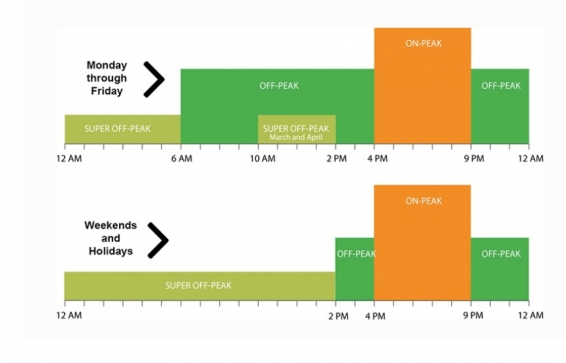
Source: Sullivan Solar Power
April 5, 2019 (San Diego) -- Beginning on March 1, 2019 SDG&E started defaulting its residential ratepayers to a new form of billing for electricity, a time-of-use rate known as “TOUDR1.” They plan to default 700,000 – 1,000,000 ratepayers per month to this time-of-use rate through mid-2020. SDG&E is mandated to provide two notices to ratepayers informing them 30 and 60 days prior to defaulting a customer, providing opportunities for ratepayers to opt out of being defaulted. See below for more details, or click here to RSVP for a seminar near you to learn more and speak with us in person.
What are time-of-use rates?
In a time-of-use billing structure, customers are charged for energy based on what time of day they use power, not just simply how much they use. In a time-of-use billing structure, hours of the day are segmented into different periods with different costs, known as “on-peak,” “semi-peak” and “off-peak” times. Rates are relevant and unique to those time periods and will differ between summer and winter months. SDG&E solar customers have already been on a mandatory time-of-use rate since March 2017, as part of the net energy metering 2.0 program for distributed generation customers.
How may I be affected?
SDG&E will be automatically defaulting their residential customers, both solar and non-solar, onto a time-of-use rate. The impact of this new rate will vary by ratepayer, depending on consumption and production patterns. SDG&E has developed a rate analysis tool to help solar customers navigate their new rate structure and determine what their new bill will be if they choose to remain on time-of-use billing. After clicking on the link, you will be asked to login to your SDG&E account.
It is imperative to do a rate analysis with SDG&E's rate analysis tool to understand which rate suits your solar system best. Just login to your account after clicking this link and you will see estimated costs associated with the various plans. Below are a few scenarios for existing solar customers to help you determine if you should opt out and remain on your current rate, or, do nothing and accept their defaulted rate.
If you went solar on or before June 29, 2016
SDG&E’s residential solar customers who went solar on or before June 29, 2016 were enrolled in the net metering 1.0 program. This program ensures grandfathering on a tiered rate for up to 20 years from the date you received permission to operate your system from the utility, so long as tiers are available and you haven’t added a significant amount of solar to your system. Net metering 1.0 customers are slated to be automatically defaulted out of tiers to time-of-use during this mass SDG&E default transition, however retain the right to opt out and return to tiers if they choose.
If you went solar between June 29, 2016 and March 1, 2017
SDG&E’s residential solar customers who went solar during this time were enrolled in the net metering 2.0 program. Due to an open rate case, SDG&E customers during this period were given a special grandfathering clause that enabled them to elect and remain on the tiered rate for up to five years after being granted permission to operate from the utility. Similarly to net metering 1.0 clients, these clients are able to remain on tiers if they wish. California Public Utilities Commission Decision 18-12-004, stated that net metering 2.0 customers on tiered rated would not be defaulted to time-of-use rates before the expiration of the five-year grandfathering period. These clients should not have to opt out to stay on tiered rates.
If you went solar after March 1, 2017
These customers are already defaulted on the current time-of-use rate, and should not be affected.
How do I contact SDG&E?
It is important that throughout 2019 and early 2020 as SDG&E defaults ratepayers that you are attentive to their notices and your account changes to secure your investment. SDG&E has developed a rate analysis tool to help customers navigate their new rate structure and determine what their new bill will be if they choose to remain on time-of-use billing. After clicking the link, you will be prompted to login to your account before being shown the different cost estimates associated with each plan. Below is a snapshot of an example analysis - as you can see, changing rates can make a big impact on your electric bill so we highly recommend you do your research as you’re typically only allowed to change rates once per year.
You can contact SDG&E by 1-800-411-SDGE (7343), but we also recommend you have written documentation of your rate change request. A simple way to document this request is to make the request through their chat feature on their website: sdge.com/live-person-chat









Recent comments